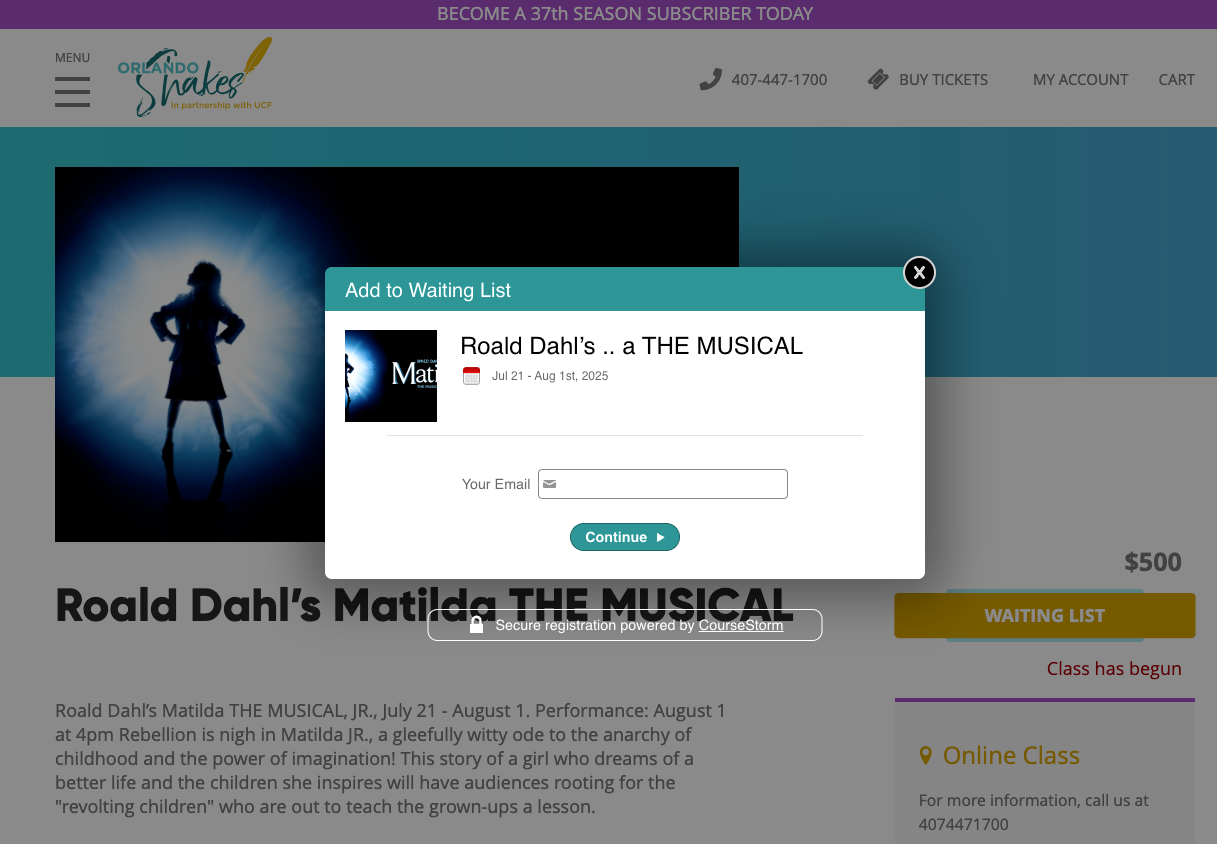Raleigh Little Theatre's Playbook for Growth



Raleigh Little Theatre has been part of its community since 1936. What began as a few friends gathering to perform has grown into one of the country’s longest-running community theatres. Today, they reach nearly 30,000 people each year through performances and education programs for every age and skill level.
Like many performing arts organizations, their team is small, but their impact is anything but. They run year-round acting classes, spring break camps, and summer intensives. They also stage 12 shows every year, ranging from Theatre for the Very Young to community musicals.
These programs create an ecosystem where education, performance, and community feed one another. And it’s working so well that Raleigh Little Theatre is quickly outgrowing their current space!
In a recent webinar, their Director of Education, Terra Hodge, and Box Office Supervisor, Mercedes Ruiz, shared how they keep every part of their organization, from classes to ticketing, working in sync with support from CourseStorm and Leap Patron Management.
We’ve compiled their insights into a playbook for arts education program success, built around our Five Pillars framework. In this article, we’ll break down:
- Each pillar in the Five Pillars of a Thriving Arts Education Program framework
- How Raleigh Little Theatre puts them into practice, and
- Steps you can take to replicate their success.
The Five Pillars of a Healthy, Sustainable Arts Education Program
Every great production starts with a strong foundation. The same is true for arts education programs. At CourseStorm, we call that foundation the Five Pillars of a Thriving Arts Education Program. This framework has been shaped by hundreds of conversations with arts leaders who are creating meaningful learning experiences in their communities.
Here’s how the pillars come together:
- Connected Catalog: Design classes and workshops that reflect your unique mission and meet real community demand.
- Stellar Student Experience: Create a smooth, inclusive journey from the first time someone interacts with your org to the moment students return for another class.
- Supportive Infrastructure: Build reliable systems that save staff time and reduce stress, allowing your team to focus on high-impact work.
- Program Integration: Align education, marketing, ticketing, and development so everyone is working toward the same shared goals.
- Strategies to Scale: Use real data and audience feedback to decide what to expand, where to invest, and how to sustain growth.
Each pillar supports the others, like stage beams supporting a set. And together, they form the foundation of Raleigh Little Theatre’s success.
#1 Connected Catalog: Design Programs That Reflect Your Community
Raleigh Little Theatre plans its classes and shows by listening to what people want. They gather input through surveys, class evaluations, and a play-reading committee that helps choose upcoming shows.
“We ask [students and parents] what classes would you like to see,” says Terra. She also conducts her own research, examining resources like Pinterest’s annual report to identify trends.
“All of a sudden you see that everyone’s into collage or a certain musical, and you start thinking about how to tap into that,” she explains.
Sometimes a new idea works beautifully, and sometimes it doesn’t. Either way, their openness keeps their programming fresh, from sensory-friendly productions to adult creativity classes. Their volunteer opportunities add another layer, giving people a chance to learn backstage theatre skills by assisting with real productions. You can browse Raleigh Little Theatre's class catalog here.
Want to build a more connected catalog? Start here:
- Send quick post-class (and post-show) polls asking, “What would you love to see next season?”
- Look at what other organizations in your community are offering and identify any niche gaps you can fill that are aligned to your unique mission.
- Use “Google Trends” and consumer trend reports to identify cultural hot topics.
- Use your research to build one “test” class each session based on trends or community requests.
- Use CourseStorm’s easy catalog builder and built-in image search to quickly bring your courses to life and drive signups.

#2 Stellar Student Experience: Create Welcoming, Seamless Journeys
At Raleigh Little Theatre, the student experience starts long before anyone steps into a classroom or theatre. Instead of asking little ones to sit still, their Theatre for the Very Young performances invite them to move, laugh, and join in the fun. Actors pause to engage with kids, and parents are encouraged to relax and enjoy the noise.
That same feeling carries through the rest of the organization. Staff greet families by name. Volunteers help new students find their classrooms. Teaching artists check in before each session and make space for questions. It’s simple, thoughtful work, but it builds trust.
A few small adjustments can make the patron and student journey much smoother:
- Map the student journey from website to follow-up email. You can broaden this exercise to look at your full patron journey but that can be a bigger undertaking so prioritize with care. The goal is to identify and fix high friction spots in your highest priority journeys.
- If you already have a good sense of the biggest pain points in the patron journey, now’s the time to determine next steps and/or make a business case for necessary fixes.
- Build accessibility into every step (e.g., physical space, sensory needs, communication) starting with the areas most important to your community.
- Use CourseStorm tools like our website embed, simple family registration, automated waitlists, and reminders to simplify signup and communication.

#3 Supportive Infrastructure: Build Systems That Support Staff
Raleigh Little Theatre’s lean team of 11 manages thousands of students, volunteers, and patrons with the help of two best-in-class tools: CourseStorm for education and LEAP Patron Management for ticketing and fundraising.
Terra uses CourseStorm to build out each session as its own catalog, duplicate classes instead of starting from scratch, and customize forms—a particularly important feature for their youth programming.
“You can ask the questions you actually need like accommodations, medical information, or emergency contacts for summer camps,” says Terra. “It saves us a lot of time.”
Mercedes said LEAP Patron Management offers similar benefits.
“I can duplicate performances, which has been so helpful. I don’t have to rebuild every price or ticket type each time,” she says. “The reporting is great too. I can pull daily, weekly, or custom reports, and even set them to email automatically.”
To strengthen your own systems:
- Speak to your team about which tasks eat up the most time, then look for ways to simplify or automate them. Similar to mapping the patron journey, this exercise is about identifying the biggest time wasters for your staff.
- Source best-in-class solutions that solve specific problems really well such as registration, ticketing, or donor management. These solutions should greatly reduce manual overload.
- Identify your most frequent reports (e.g., weekly class registration summaries, ticket sales updates, volunteer schedules) and build templates you can reuse each session. Do the same for common communications, like registration confirmations, waitlist notifications, and class reminders, to cut repetitive work.
- Take advantage of CourseStorm's "Just Ask" reporting assistant (shown below) to get the data and insights you need for grant and board reporting by simply asking a question.
#4 Program Integration: Make Education and Performance Work Together
Collaboration is part of the script at Raleigh Little Theatre. Education and production teams share the same stage, literally and figuratively.
“They aren’t two separate entities,” says Terra. “We want our audiences to take advantage of our classes and our class participants to come see our shows.”
For example, before a recent performance of Mad Libs Live!, a musical full of audience participation, they offered a family improv workshop to help audiences take part in the performance. They also offer study guides for school matinees and shared teaching roles through programs like Teens on Stage and their Creative Team Workshop Series, where production staff teach directing and design.
Raleigh Little Theatre interweaves programs and uses one to feed the other. This integrated mentality is supported from the top down and from the bottom up, with leadership buy-in and support of both live performance and education, as well as meetings and interactions that support cross-team collaboration.
“We honor the idea that artists can be involved in multiple ways,” explains Mercedes. “One of my box office associates also stage manages and works in the costume shop. You’re never limited to one track here.”
To help your own programs work together more seamlessly:
- Hold regular cross-team check-ins between education, box office, development, and marketing to uncover collaboration opportunities. Look for natural overlaps, like an acting class that could promote an upcoming play, or a stagecraft course to support your backstage volunteer team.
- Add interactive touch points around your shows to deepen engagement. Host a pre-show improv class inspired by a comedy, or a family night with hands-on activities that tie into a children’s production.
- Integrate your major systems so you can gather all of your patron data in one place. This will allow you to understand trends across your programs and build relevant integrated offerings.
- Ask questions like: Which classes sell out fastest or attract repeat students? Use that data to guide future scheduling. If a certain offering or topic is particularly popular, consider building future productions, workshops, or marketing campaigns to tap into that demand.
Are you a current Patron Manager customer? Learn more about the CourseStorm + Patron Management integration here and talk to our team take advantage of our special promotion now through Dec 31st!
#5 Strategies to Scale: Grow With Intention
Raleigh Little Theatre is thriving because patrons don’t just show up once and move on. They come back again and again, often with their whole family and sometimes, across generations.
Mercedes knows this firsthand. “When I was little, I went to shows here with my grandfather. Then I took classes, became a teaching artist, and now I’m on staff,” she said.
“When I was little, I went to shows here with my grandfather. Then I took classes, became a teaching artist, and now I’m on staff,” shares Mercedes Ruiz.
This all-ages model builds loyalty and growth that lasts. By creating opportunities for every family member to stay involved, Raleigh Little Theatre builds stronger, deeper connections with the people they already serve.
You can grow the same way by:
- Continuously look for opportunities to bridge learning and live performance. Offer acting students discounted tickets to related shows, or invite audience members to join a one-day class exploring the play’s theme or time period. Each interaction with your organization is a chance to build good will and loyalty.
- Use your centralized patron data to segment and personalize outreach. Share early registration access with returning students or reach out to volunteers about upcoming behind-the-scenes workshops.
- Use CourseStorm’s auto-marketing features to send friendly reminders and personalized recommendations that keep your classes and camps top of mind and bring families back each season.

Borrow What Raleigh Little Theatre Gets Right
The thread running through Raleigh Little Theatre’s story is connection. Every part of their organization feeds the next. Education builds audiences, performances spark new classes, and systems keep it all moving.
Terra said it best: “You can’t have a successful production or theater program without building your ensemble.” When everyone’s working toward the same goal, and you have the right tools in place, everything starts to click.
That’s what the five pillars are all about: building stronger connections that help your programs run smarter, not harder.
If you're ready to take your arts education program to the next level, now's the time to check out CourseStorm. Get your free demo today.
Save time and grow your impact with CourseStorm










